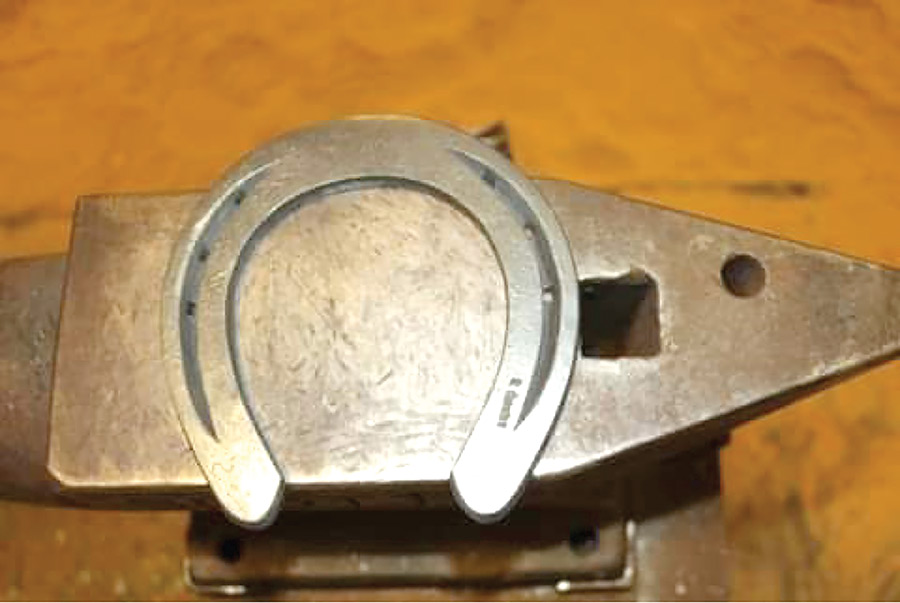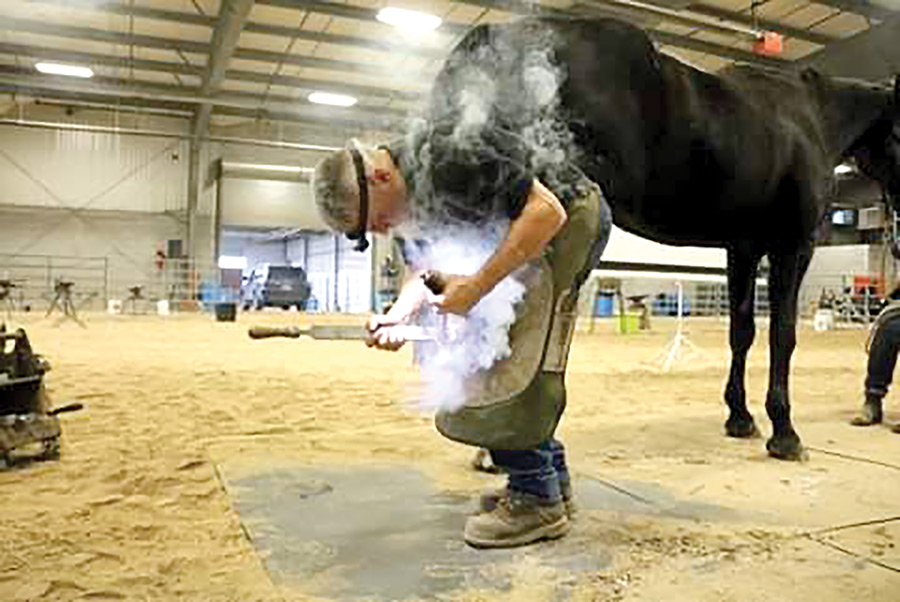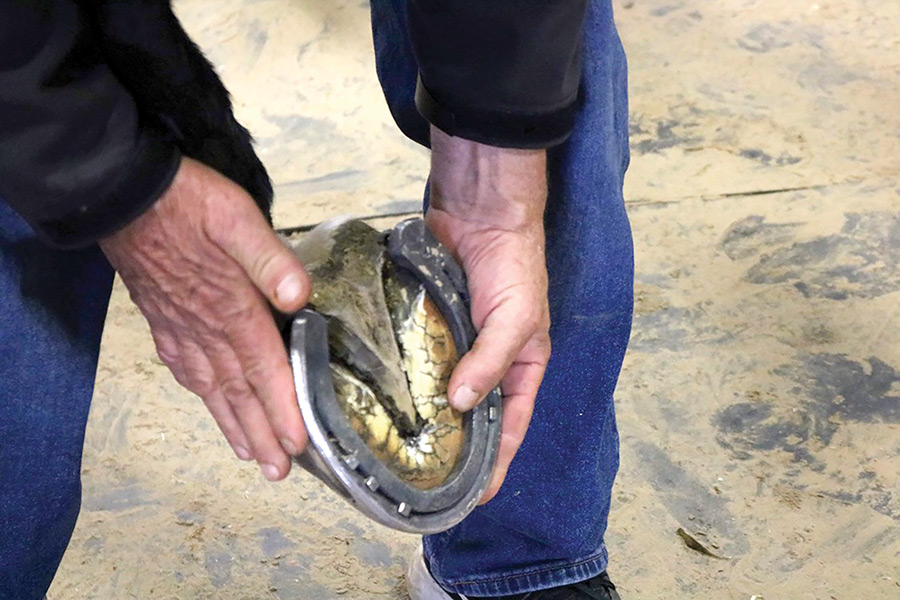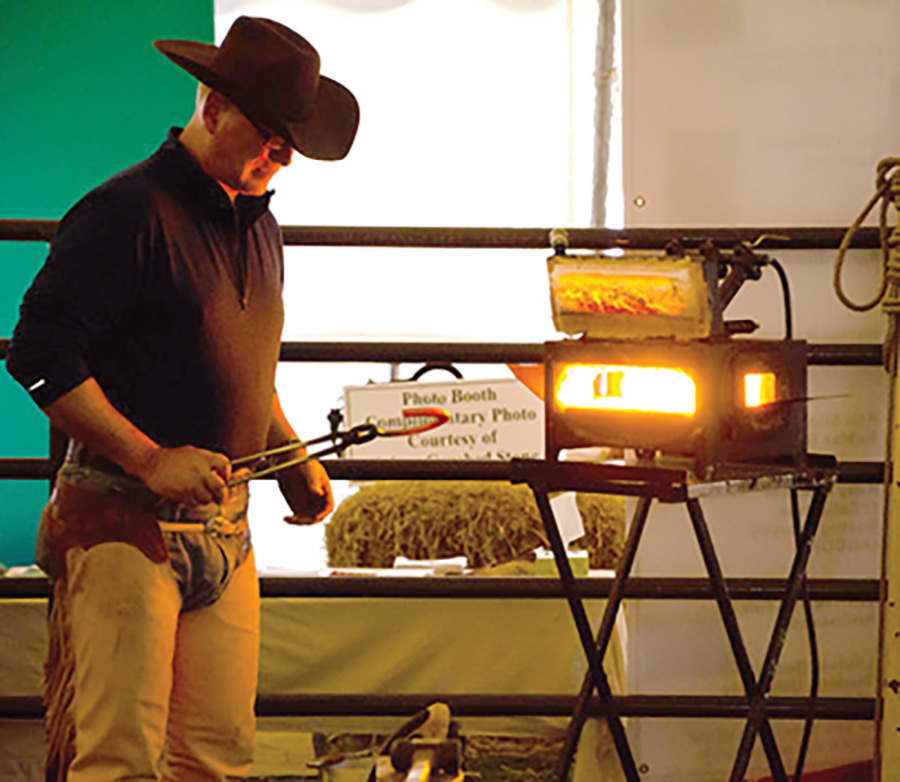ORANGEVILLE – The trade of a farrier can be rigorous and demanding. As one of the world’s oldest professions, and it still holds a hint of nostalgia.
A farrier is sometimes also referred to as a blacksmith. This goes back to when the village blacksmith or “smithy” worked at a high temperature forge to melt and shape iron into horse shoes, wheel rims, tools and other items.
A blacksmith works with iron, but may not have any contact with horses. The word farrier comes from the Latin word, ferrum, meaning iron, and today’s farriers are hoof specialists. Their job entails trimming and caring for horses’ hooves as well as shaping and applying horse shoes.

A horseshoe on an anvil.
Vic Coy photo
Men and women getting into this business require a variety of education, technical skills, and work experience to be successful. Equine knowledge and hoof anatomy is key.
Working underneath a horse requires patience and awareness; farrier and horse need to offer each other mutual respect. If a farrier is working with a forge (the heat source or fire) doing a hot-shoeing process, understanding and implementing safety precautions, is crucial. Insurance rates in this business are high.
While these skills can be taught, much of the real learning takes place on the job, working with horses.
The farrier industry in Canada is currently unregulated and there is no central organization or government body governing or funding it. Without regulation, anyone in Ontario could start a farrier business without proven skills or experience.

Hot shoeing in process at the 2020 OFA conference in Orangeville. Vic Coy photo
Mike Mehak of Orangeville is president of the Ontario Farrier’s Association (OFA). The OFA acts as a common voice for its members, provides education and certification clinics and lists of farriers by region.
Mehak suggests the best way to get started is to first do research, and then connect directly with an experienced farrier.
“Go for a ride-along, and take a closer look at the trade, he advises.
“Once you have decided that it is for you, go to school and learn the basics. Upon completion of your education, seek out a mentor. Apprentice for one to two years and slowly build your own clientele. There is a no shortage of work.”
The common accreditation used by Canadian farriers is based on the American Farrier’s Association (AFA) standard. CF stands for Certified Farrier. This requires farriers to meet or surpass certain requirements to obtain certification. CJF stands for Certified Journeyman Farrier and requires a more advanced level and testing for technical skills and forging abilities.
Job opportunities in this field include trimming and shoeing: recreational horses and family farms, therapeutic and corrective shoeing (often working with a veterinarian), performance horses (heavy horse, reining, dressage, jumping etc.), working ranches, summer camps, outfitters and dude ranches, mounted units and the racing industry.
Today’s equine industry requires farriers with an understanding in the newest techniques and products to serve a changing industry.
There is a wide variety of iron and light metal shoes, some incorporating rubber or cork. New technology includes fitted boots and plastic shoes which are glued on in cases where there may not enough hoof wall to nail into. Today, a farrier may trim only, or use pre-fabricated shoes as needed.

A finished shoe applied to a hoof.
Vic Coy photo
According to experienced farriers, education and apprenticeship sets the groundwork for a solid career.
Sean Elliot, of Grand Valley (The Village Smithy) has been a mentor within the trade for over 20 years. Elliot is a CJF and is active within the horse community, supporting equine education such as programs offered by Equine Guelph/University of Guelph.
Elliot has worked with many students and helps his interns to understand how to address hoof problems connected to conformation, injury, cracks, abscesses, and laminitis.
Elliot reminds his students that this is a lifelong study, and there is always something more to learn. When not busy with horses, Elliot creates unique furniture and crafts handmade items out of iron.
Farrier Paul Fischbach, from Fergus is a strong advocate for combining education with hands-on learning and mentorship.
Fischbach says: “An experienced farrier can teach students how to trim correctly so that the hoof is balanced; when a shoe is applied to a balanced trim, it fits better.”
In April of this year, Fischbach is launching The Horseshoeing School of Canada, based out of Breslau. The school will include a three-month program and instruction on horse hoof health, shoeing and forging basics, and field experience working on live horses.
Originally from Switzerland, Fischbach trained as a machinist (tool and die maker) which included forging and farrier work.
He has been a passionate advocate for the industry, often presenting lectures and clinics at local horse events. Fischbach’s hot shoeing demos at the Erin Fair Horse Tent have always attracted a large audience.
Education programs range from three-to-six month courses, up to one year. Tuition fees are about $9,000 per course. Additional costs include anvils, tools, rasps, knives, aprons and materials, at an estimated a $2,500.
Accredited programs in Canada are offered at Kwantlen Polytechnic University, near Vancouver B.C., and Olds College Farrier Science Certificate in Olds, Alberta. The Olds program teaches applied and practical training in farriery, blacksmithing, anatomy and physiology, horsemanship, welding, record keeping and human relations.
Horses need to be trimmed or shoed every six to eight weeks to stay healthy and balanced.
Farrier fees vary, with trims starting at $35 and ranging up to $50. Shoeing starts from $150/set and goes as high as $350 for specialized shoes. Mini horses, ponies and donkeys are not cheaper; although they are smaller, they may take longer to trim and shoe.
Farriers can spend a lot of time driving and getting to the horses and stables they service. One farrier said he put over 50,000km/year on his truck, so on top of a forge, anvil and other tools, a good vehicle is a must.
Traditionally, the farrier trade is practiced by males, however more women are now getting into the field.
Vic Coy, a young woman whose mentor is Cathy Lesperance, the first female farrier in this area, has a solid reputation spanning over 30 years.
Coy describes herself as a small woman and says it is important to use your body correctly to reduce strain when trimming and shoeing. Coy says she does yoga and rides her horse to relax and support her back muscles.
As the saying goes, “no hoof, no horse.” At the end of the day, a good farrier requires strong technical skills, education in horse anatomy, effective horsemanship and well-rounded apprenticeship to create a successful business.




